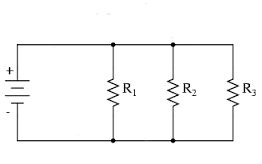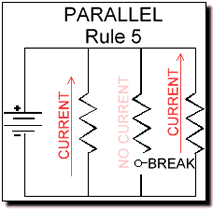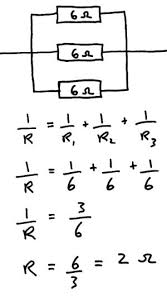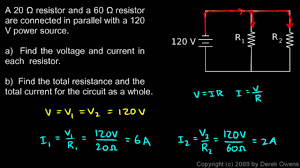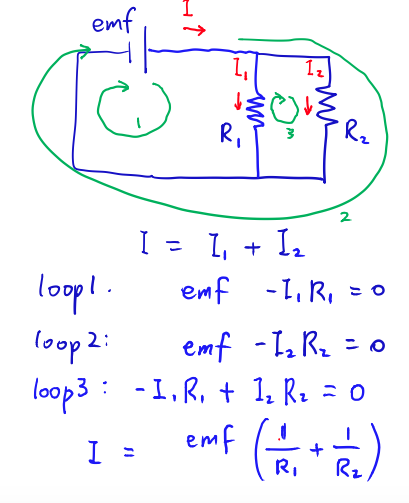Parallel CIrcuits: Difference between revisions
Tcraport25 (talk | contribs) |
Tcraport25 (talk | contribs) |
||
| Line 28: | Line 28: | ||
==Examples== | ==Examples== | ||
Below are three levels of examples. While all contain only Resistors and one battery, it is important to understand that capacitors, multiple batteries, and potentially inductors that effect current flow and charge through the entire circuit. | |||
===Simple=== | ===Simple=== | ||
[[File:SimpletotalR.jpg]] | [[File:SimpletotalR.jpg]] | ||
This example is a basic problem of calculating total resistance looking at three resistors in parallel. Using the resistance formula from above, we know that '''1/Req = 1/R1 + 1/R2 + 1/R3'''. From there, we plug in the known values of the three resistors and solve for Req. This value comes to 2 ohms. To further expand on this calculation, having these three 6 ohm restores in parallel is equivalent to having one 2 ohm resistor in series alone. | |||
===Middling=== | ===Middling=== | ||
Revision as of 13:01, 14 April 2016
Claimed by Trevor Craport
This page covers one of the two types of basic circuits covered in this course, Parallel Circuits.
The Main Idea
Parallel circuits are a type of circuit that are composed of multiple paths that the current can pass through. Each path is independent of one another and if one path were to go out, the others would still have current passing through them. There are five basic rules/characteristics for parallel circuits. These rules include: the current has two or more separate paths to travel through, the voltage is the same across every path in a parallel circuit, the sum of current through each path is equal to the total current that comes into and out of the circuit as a whole, total resistance is determined by the equation 1/Req = 1/R1 + 1/R2 + 1/R3 +1/Rn, and each path is independent of one another in that if one path were to go out, the values of current through each path would change, but would not go out like it would in series.
A Mathematical Model
For parallel circuits, there are a few equations that are necessary to know and understand so that you are able to solve for any missing part of a circuit problem.
Total resistance RT for resistors in parallel: 1/RT = 1/R1 + 1/R2 + 1/R3 + ...
Voltage is always the same across branches: VT = V1 = V2 = V3 = ...
Total current (Node rule) IT = I1 + I2 + I3 + ...
Ohm's Law: V = IR
Each of these equations are useful in deterring select aspects of parallel circuits that may be missing in problems related to this topic. Each problem starts with the loop rule, node rule, and Ohm's law to define any variable given so that additional variables and components of the circuit can be identified and calculated.
Examples
Below are three levels of examples. While all contain only Resistors and one battery, it is important to understand that capacitors, multiple batteries, and potentially inductors that effect current flow and charge through the entire circuit.
Simple
This example is a basic problem of calculating total resistance looking at three resistors in parallel. Using the resistance formula from above, we know that 1/Req = 1/R1 + 1/R2 + 1/R3. From there, we plug in the known values of the three resistors and solve for Req. This value comes to 2 ohms. To further expand on this calculation, having these three 6 ohm restores in parallel is equivalent to having one 2 ohm resistor in series alone.
Middling
Difficult
Connectedness
- How is this topic connected to something that you are interested in?
- How is it connected to your major?
- Is there an interesting industrial application?
History
Put this idea in historical context. Give the reader the Who, What, When, Where, and Why.
See also
Parallel Circuits are just one component of the total circuit composition. In this physics book page, there are further extensions on the other basic type of circuit as well as many variations in laws that originate from them.
http://www.physicsbook.gatech.edu/Series_Circuits
http://www.physicsbook.gatech.edu/Parallel_Circuits_vs._Series_Circuits*
http://www.physicsbook.gatech.edu/Loop_Rule
http://www.physicsbook.gatech.edu/Node_Rule
External links
http://www.wikihow.com/Solve-Parallel-Circuits
References
https://www.swtc.edu/Ag_Power/electrical/lecture/parallel_circuits.htm
http://www.physicsclassroom.com/class/circuits/Lesson-4/Parallel-Circuits
Professor Kim's lecture on Loop rule of parallel circuits
